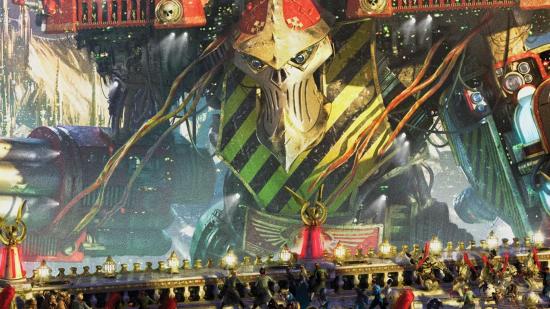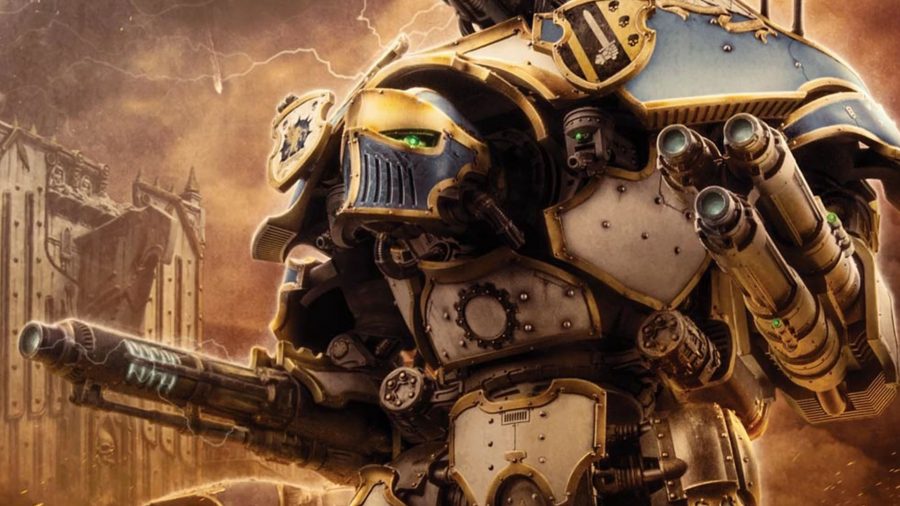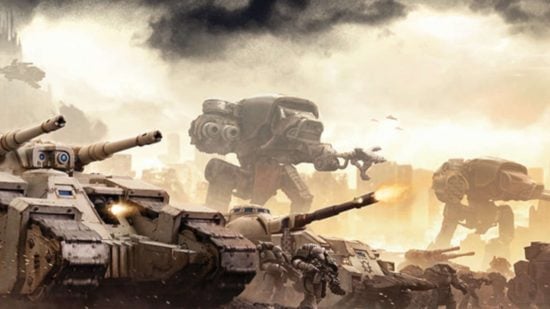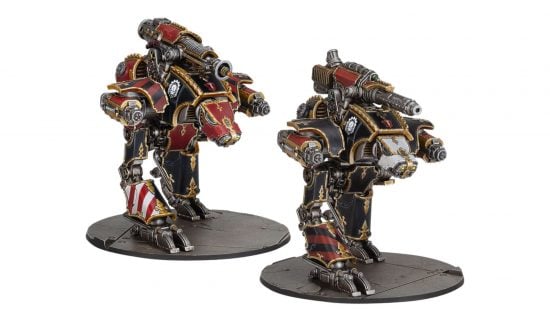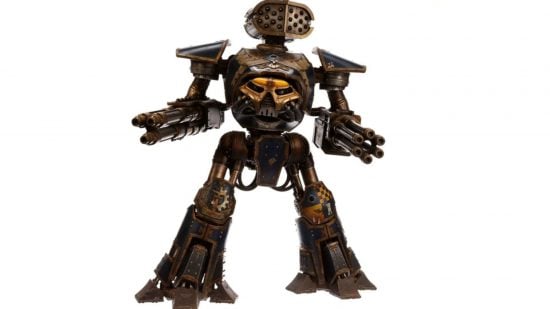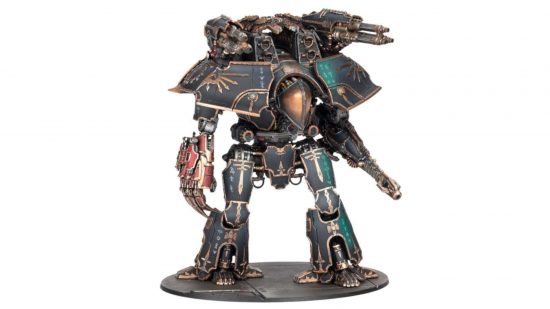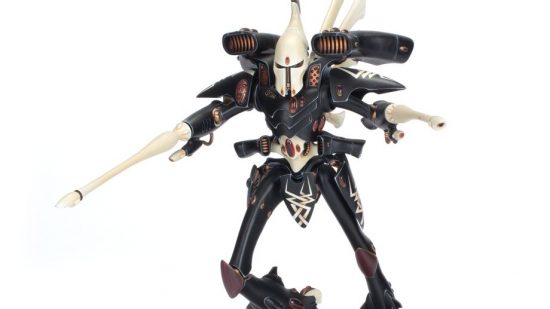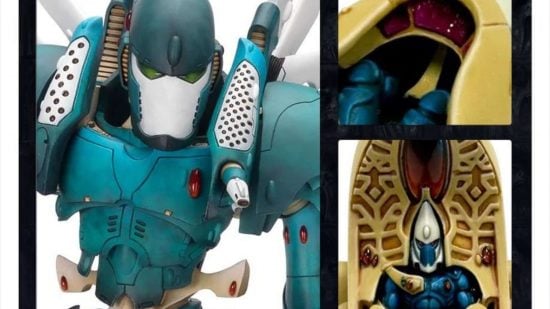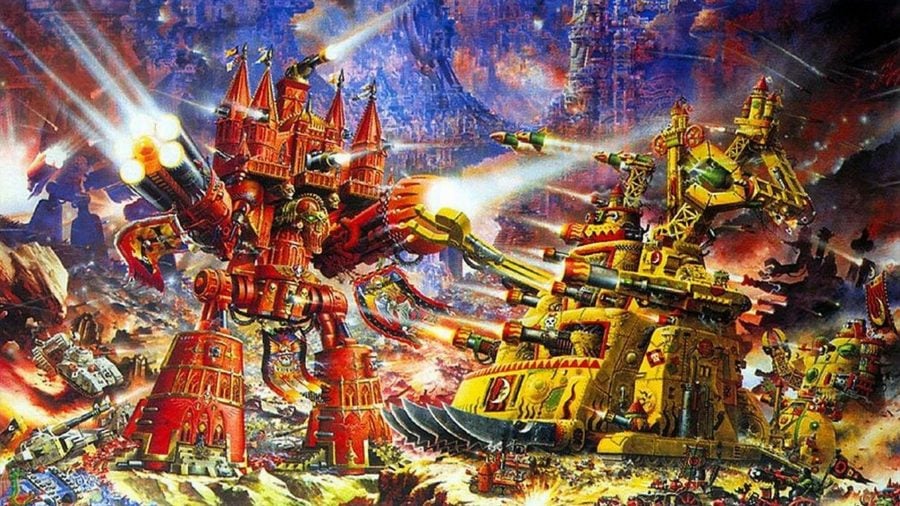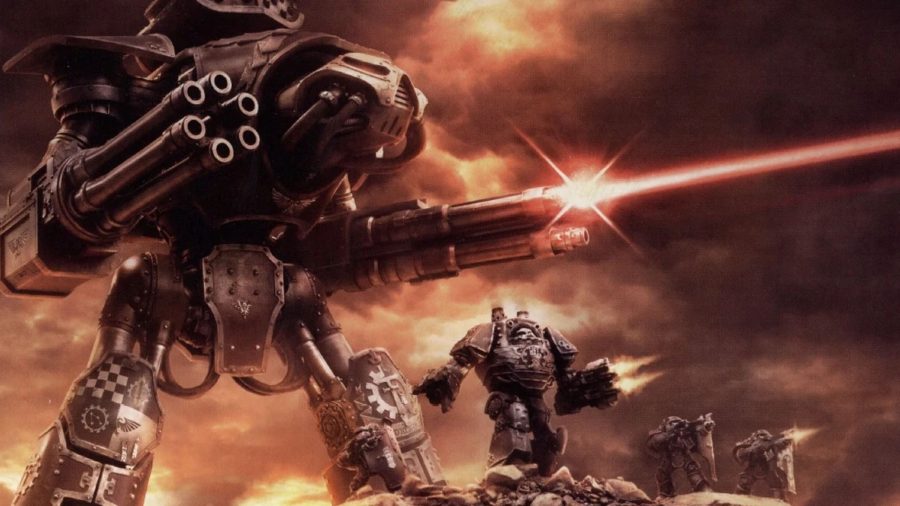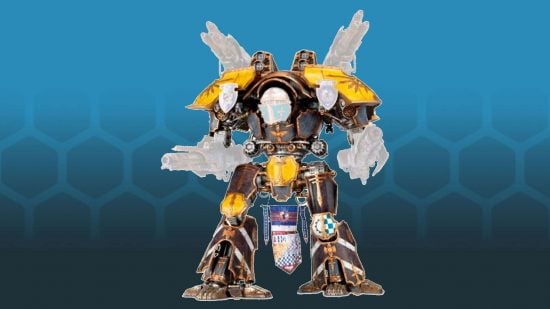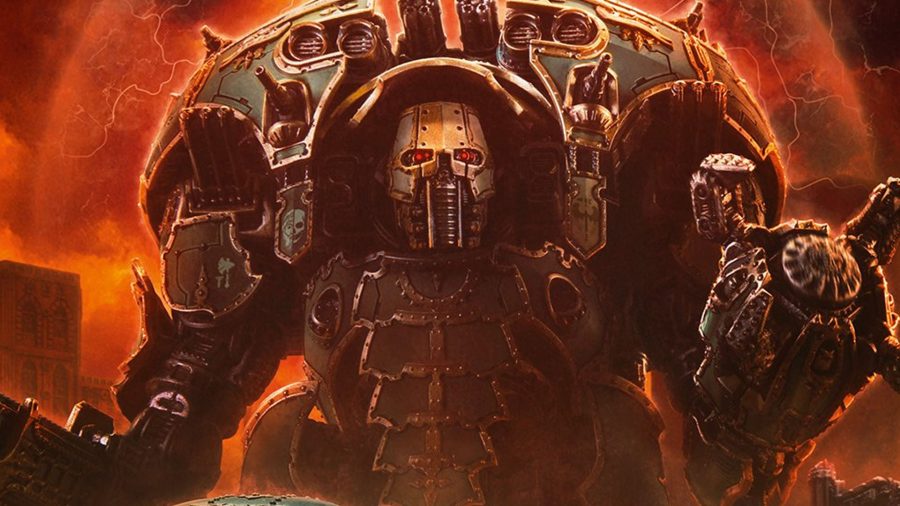To understand Warhammer titans, you have to understand that the universe of Warhammer 40,000 is one where hyperbole knows no limits. Gods and daemons clash for the souls of humanity, aliens eat entire civilisations to feed their eternal hunger, and magic-like psychic powers are tossed about with an abandon that would make Steve Ditko blush.
The scale of Warhammer 40k is so large it beggars belief. Similarly, a few of the game’s ‘miniatures’ push the concept of a ‘miniature’ to its very limit: Warhammer’s titans.
You won’t see Titans used on the tabletop very often but, when you do, it’s always an event. So large they could almost be considered ‘maxiatures’, they exemplify the spirit of colossal warfare; giants in name, and giants on the tabletop too.

In the lore, they stand even taller – god-machines that loom above the battlefield like sky-piercing nightmares of flesh and steel. Creations so large they blur the lines between mountain, building, and machine.
Many races and factions in Warhammer 40,000 have their own titans, each reflecting the doctrine, culture, and technology of the species that created it.
These range from fleshy Tyranid Bio-titans to stalwart relics crafted through forgotten Imperium technology. In addition to having strong appearances in the various works of fiction, titans can also appear on the tabletop, though not all have models currently available for purchase.
Come with us on a journey to feel the thunder of their passing, as we look at what titans are – and how you can play them in Warhammer 40k.
Here’s what you need to know about Warhammer titans:
- Imperial titans
- Chaos titans
- Eldar titans
- Tyranid bio-titans
- Ork gargants
- Where to buy Warhammer titans
- Warhammer 40k titan rules
Imperial titans
Imperial titans are the might of the God-Emperor of Mankind made physical. Warhammer 40k’s Imperium of Man is fading, beset on all sides by enemies and controlled by a doctrine that prevents innovation. Titans are its most potent war engines, and they are all but irreplaceable.
Maintained by legions of dedicated Adeptus Mechanicus tech-priests; crewed by Collegia Titanica specialists; and flanked by liveried lances of noble Imperial Knights; Imperial titans are vast icons of worship as well as tools of war.
The crew of a titan consists of a Princeps and his Moderati, psionically connected to the machine spirit of the mighty war machine via their mind-interface-units (MIU). Its heart of plasma fire is tended by one or more Tech Priests and their servitors. The very largest Titans may even host garrisons of Skitarii tech-guard to repulse borders.
Titans can come in a range of colossal sizes, each designed to fill a particular role on the battlefield.
Warhound titans
Warhound titans are fast, mobile creatures that hunt across warzones. Smaller than many of their siblings, they still stand 15 metres (45 feet) tall. Imagine them like their namesakes; they hunt, they flank, and they team up to take down larger prey. Their armament is extremely varied, from infantry-clearing flamestorm cannons, potent anti-armor plasma blasters, or rapid firing vulcan megabolters.
Dire Wolf titans
Dire Wolf titans are heavy scouts. Though similar in profile to the Warhound they are bulkier, up-armored, with more heavily braced leg locomotors. Where the Warhound has two arm mounted weapons the Dire Wolf has far smaller Ardex-Defensor Megabolters. On its stooped back it carries a single, Reaver-class main gun, such as a Neutron Laser or Volcano Cannon.
Reaver titans
Reaver titans are the main line brawlers of the Titan Legions. Taller and more heavily armed than the Warhounds, but nowhere near as ponderous as the Warlord, they combine substantial firepower and multiple layers of void shielding with respectable manoeuvrability. They mount two arm-guns, and a single carapace-mounted weapons system.
Nemesis titans
Slightly heavier than Reaver titans though bearing the same category of arm-mounted weaponry, Nemesis titans specialise in long ranged combat. Their upper carapace bears a huge weapons platform, complete with anti-air fire support battery and the mountings for a huge, Warlord class gun, such as a Belicosa Volcano Cannon or Earthquake Cannon. These weapons can provide long-range artillery support, or even target enemy void ship assets.
Warlord titans
The most iconic titan in the ranks of the Imperium is the Warlord battle titan. Standing 33 metres (108 feet) tall, Warlords can be equipped in a variety of ways, with loadouts that range from Volcano Cannons and Vulcan Mega-Bolters to Arioch Power Claws.
Warlord battle titans have several subclasses, named ‘Patterns’, which further increase their versatility on the battlefield. For example, Mars Pattern Warlord titans are of ancient design, dating back to the ancient forge world of Mars itself. Fitted with a devastating bevy of guns, a single Mars Pattern Warlord Titan can turn the tide of a war in moments.
Psi-titans
The Psi-titans of the Ordo Sinister were one of the Emperor’s ultimate war-machines, unleashed in the closing stages of the Siege of Terra during the Horus Heresy. Though built on the chassis of a Warlord titan, each was powered by a battery of potent psychics, controlled by a Pariah psychic null. These abominable war engines could rework the fabric of reality, accelerating at impossible speeds, undoing devastating injuries, or conjuring devastating blasts of unreality.
![]()
Emperor titans
The largest type of Imperial Titan is the Emperor titan, which has two subclasses: Imperator titans and Warmonger titans. These walking fortresses are so large they can almost be considered moving mountains. In addition to their truly awe-inspiring amount of weaponry, Emperor titans can carry entire companies of troops. Simply put, if you see the crenelated crest of an Emperor Titan rising above the horizon, run.
Chaos Titans
After the Horus Heresy civil, traitor legions that had turned upon the Imperium fled to secret hiding places beyond the stars. Many Adeptus Mechanicus (then called Mechanicum) factions turned traitor along with the Warmaster Horus and, when they found themselves on the losing side of the war, fled alongside their Chaos Space Marine brethren.
Titans also made the journey to the Eye of Terror along with their disgraced Chaos-aligned Collegia Titanica crews. As a result, many Imperial titans have their dark mirrors amongst the forces of Chaos, albeit with twisted Dark Mechanicus alterations and daemonic infestations.
Chaos Warhound titans
Chaos Warhound titans take the bestial aspect of their Imperial counterparts even further. They are ravenous dogs, savage pack hunters, herding lesser prey and ripping it apart with savage bursts of their guns, or circling mightier opponents and bringing them down with coordinated ambushes.
Chaos Reaver titans
Chaos Reaver titans are one of the more common Chaos titans encountered on the battlefield. They differ vastly from their Imperial cousins, with their crews and even internal architecture possessed entirely by daemons, making them breathe with an unholy life.
Chaos Warlord titans
Chaos Warlord titans have been spotted striding distant worlds, destroying all they encounter. Similar at first glance to original, loyalist Warlord titans, it’s only with a closer look that their aberrations become apparent.
Instead of holy Imperial iconography, these machines are covered in runes and other daemonic symbols. In addition, their weaponry can be vastly different, including cruel Chaos Energy Whips and Chaos Titan Tails.
Eldar Titans
Where Imperial titans are heavy, squat machines that brute-force their way into every forward step, Eldar titans are vastly different. Graceful, slim, and impossibly tall, the titans of Warhammer 40k Eldar armies don’t walk the battlefield – they appear to dance through it.
Constructed of wraithbone, that same mysterious material used for many of the Eldar tanks and even their Craftworlds, Eldar titans incorporate fallen Aeldari spirits at their core. Their crew are often twins or triplets, raised alongside the titan in lockstep from birth, becoming emotionally bonded with the spirit inhabiting the titan.
It’s this bond that can make Eldar titans appear almost supernatural when fighting, acting with a grace and speed that seems impossible for a war machine of such size.
Eldar Revenant titans
Revenant titans take the approach to gracefulness to extremes. The smallest type of Eldar titan, Revenant titans can leap and run across the battlefield faster than any opponent can believe. Similar to Warhound titans, they tend to act in packs, using their deadly weaponry to gang up on tougher targets and bring them down.
Eldar Phantom titans
At the other end of the scale come Phantom titans. They tower over their foes but still move with the speed and skill expected of the Eldar, their Steersmen fully integrated into one gestalt entity inside the titan. Armed with the most powerful weapons the Aeldari can muster, Phantom titans can often be seen with Phantom Titan Pulsars, Distortion Cannons, or even Ashuna-Valcry’le Power Glaives.
Warlock battle titans
Warlock battle titans take the merging of soul and titan to the logical conclusion, by bringing together the souls of dead Warlocks with these titanic Wraithbone bodies. This gives them psychic powers they can unleash, along with foresight born of their innate witch sight. This makes them especially powerful against foes born of the Immaterium, such as the forces of Chaos.
Tyranid Bio-titans
Much like the Tyranids themselves, Tyranid Bio-titans are utterly alien and are grown rather than constructed.
Formed out of several different giant creatures, Bio-titans can take on a multitude of different forms depending on the requirements of the greater Hive.
Tyranid Hierophants are flesh made into walking battle platforms. Hideous, spider-like creatures that scuttle with heavy steps over the battlefield, Hierophants are amongst the largest Bio-titans that anyone has yet encountered (or rather, encountered and survived long enough to report back about).
Armed with huge Bio-Cannons, chitin blades, and claws that can rend metal as easily as flesh, they are an existential threat larger than almost any encountered by the Imperium of Man.
Ork Gargants
Warhammer 40k Orks make their titans much like they do all their technology. They smash things together, use a bit of luck, throw in a dash of some half-forgotten, inborn understanding of technology, and an Ork Gargant is the final result.
Devoted to their twin gods, Gork and Mork, and even shaped in their image, Gargants are technological marvels. By that we mean it’s a marvel they work at all, as they appear to be more moving rubbish heaps than defined machines crafted to a singular purpose. Instead of sleek lines – as seen in Eldar titans – or even the square, brutish architecture of Imperial titans, Ork Gargants look almost like steam tanks, if steam tanks could stand hundreds of feet tall.
Though simpler than other variants of Titan, Gargants are still utterly deadly in combat and veritably bristle with armaments. Their most iconic weapon is the belly gun, which tends to hold a Gut Buster mega-cannon capable of spitting out shells the size of Warbikes. Gargants may look simple, but this simplicity belies a destructive capability on par with the best any other faction can field.
Where to buy Warhammer titans
Now we’ve covered what titans are, it’s time to take a look at how you can get your own hands on one, as well as a quick primer on how they perform on the tabletop.
Titan models are an investment. The Warhammer 40k section on the Forge World website is the best place to start your journey towards Titan ownership. There you can browse all the Forge World titans, from Chaos Reaver titans and Warhound titans to Mars-Alpha Pattern Warlord titans.
Typically you’ll buy the body, and then pick out your own weapons in order to arm your Titan. The exception to this is the Tyranid Hierophant Bio-Titan, which comes with one loadout.
If (like us) your budget doesn’t quite stretch that far, you can always try GW’s small scale Adeptus Titanicus and Legions Imperialis miniature games, for which we’ve provided a few example kit links here, .
Warhammer 40k titan rules
You’ve bought a Titan for your army, you’ve painted it (well done, that takes a while), and now you’re ready to deploy it on the battlefield against an unsuspecting foe. But where do you get the Warhammer 40k Titan rules?
The rules for Titans are separated out into the Imperial Armor PDFs. For Chaos, Eldar, Ork, and Tyranid Titans, you’ll find them in their respective faction Imperial Armor PDFs, which you can download from the Warhammer Community website. Imperial Titans get an Imperial Armor PDF all to themselves.
Even the smallest Titan is more expensive to field than any other unit. Titans cost thousands of points (matching their thousand-dollar pricepoint). You can actually include Titans in other armies, thanks to the Titanic Support rule, but you need to be playing a very big game to warrant it!
Even if your titan should face death, it’s possible for it to deal damage if its reactor overloads. This has the potential of dealing 3D6 mortal wounds to every model within 4D6 inches. If there’s anything that’ll turn a moment of victory into a crushing defeat, it’s that.
Titans are colossal in every sense of the word. From their lore and backstory to their size on the tabletop to the threat they represent for your friends should they attempt to take you on. This is entirely as they should be, they’re titanic, after all.
If you want to play with titans but aren’t quite prepared to take the plunge on the colossal 40k scale titans, check out our Legions Imperialis review for our take on GW’s game of massive titans and teeny infantry – we’re still building battlefields of teeny tiny Legions Imperialis terrain, perfect for our titan legions to stomp through.
